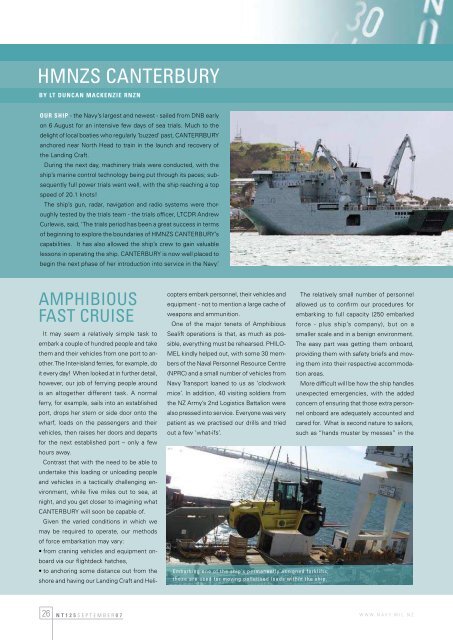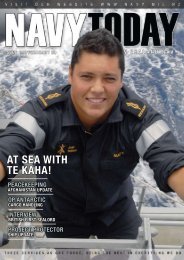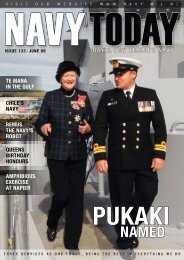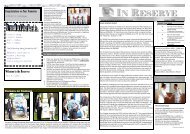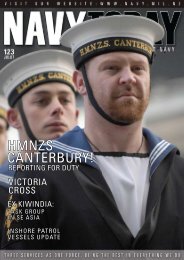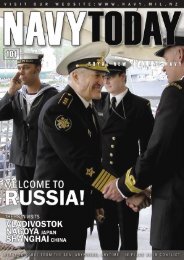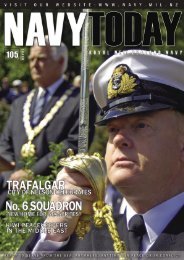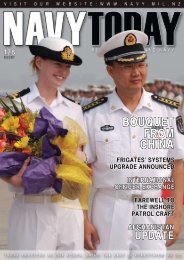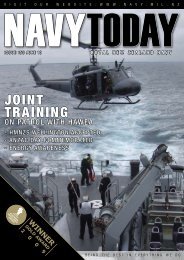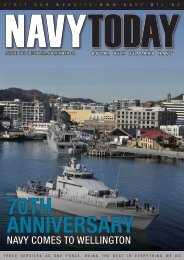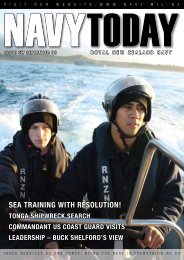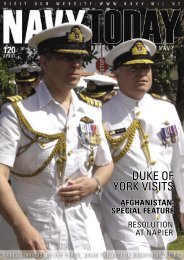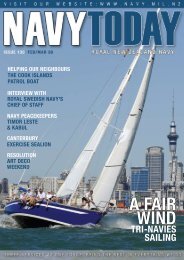You also want an ePaper? Increase the reach of your titles
YUMPU automatically turns print PDFs into web optimized ePapers that Google loves.
FLEET PROGRESS<br />
HMNZS CANTERBURY<br />
BY LT DUNCAN MACKENZIE RNZN<br />
OUR SHIP - the <strong>Navy</strong>’s largest and newest - sailed from DNB early<br />
on 6 August for an intensive few days of sea trials. Much to the<br />
delight of local boaties who regularly ‘buzzed’ past, CANTERRBURY<br />
anchored near North Head to train in the launch and recovery of<br />
the Landing Craft.<br />
During the next day, machinery trials were conducted, with the<br />
ship’s marine control technology being put through its paces; subsequently<br />
full power trials went well, with the ship reaching a top<br />
speed of 20.1 knots!<br />
The ship’s gun, radar, navigation and radio systems were thoroughly<br />
tested by the trials team - the trials officer, LTCDR Andrew<br />
Curlewis, said, ‘The trials period has been a great success in terms<br />
of beginning to explore the boundaries of HMNZS CANTERBURY’s<br />
capabilities. It has also allowed the ship’s crew to gain valuable<br />
lessons in operating the ship. CANTERBURY is now well placed to<br />
begin the next phase of her introduction into service in the <strong>Navy</strong>.’<br />
AMPHIBIOUS<br />
FAST CRUISE<br />
It may seem a relatively simple task to<br />
embark a couple of hundred people and take<br />
them and their vehicles from one port to another.<br />
The Inter-island ferries, for example, do<br />
it every day! When looked at in further detail,<br />
however, our job of ferrying people around<br />
is an altogether different task. A normal<br />
ferry, for example, sails into an established<br />
port, drops her stern or side door onto the<br />
wharf, loads on the passengers and their<br />
vehicles, then raises her doors and departs<br />
for the next established port – only a few<br />
hours away.<br />
Contrast that with the need to be able to<br />
undertake this loading or unloading people<br />
and vehicles in a tactically challenging environment,<br />
while five miles out to sea, at<br />
night, and you get closer to imagining what<br />
CANTERBURY will soon be capable of.<br />
Given the varied conditions in which we<br />
may be required to operate, our methods<br />
of force embarkation may vary:<br />
• from craning vehicles and equipment onboard<br />
via our flightdeck hatches,<br />
• to anchoring some distance out from the<br />
shore and having our Landing Craft and Heli-<br />
copters embark personnel, their vehicles and<br />
equipment - not to mention a large cache of<br />
weapons and ammunition.<br />
One of the major tenets of Amphibious<br />
Sealift operations is that, as much as possible,<br />
everything must be rehearsed. PHILO-<br />
MEL kindly helped out, with some 30 members<br />
of the Naval Personnel Resource Centre<br />
(NPRC) and a small number of vehicles from<br />
<strong>Navy</strong> Transport loaned to us as ‘clockwork<br />
mice’. In addition, 40 visiting soldiers from<br />
the NZ Army’s 2nd Logistics Battalion were<br />
also pressed into service. Everyone was very<br />
patient as we practised our drills and tried<br />
out a few ‘what-ifs’.<br />
Embarking one of the ship’s permanently assigned forklifts;<br />
these are used for moving palletised loads within the ship.<br />
The relatively small number of personnel<br />
allowed us to confirm our procedures for<br />
embarking to full capacity (250 embarked<br />
force - plus ship’s company), but on a<br />
smaller scale and in a benign environment.<br />
The easy part was getting them onboard,<br />
providing them with safety briefs and moving<br />
them into their respective accommodation<br />
areas.<br />
More difficult will be how the ship handles<br />
unexpected emergencies, with the added<br />
concern of ensuring that those extra personnel<br />
onboard are adequately accounted and<br />
cared for. What is second nature to sailors,<br />
such as “hands muster by messes” in the<br />
event of a Man overboard, or acting as an<br />
“initial attack” in the event of a damage control<br />
emergency, is completely foreign to the<br />
many Army, Air Force and civilian personnel<br />
that we can be expected to have onboard at<br />
any time. Try mustering 450% of your regular<br />
Ship’s Company in the “Fleet Standard”<br />
7 minutes!<br />
Now that the ship has passed the first<br />
hurdle of welcoming just a few ‘extras’ onboard,<br />
the next step will be a full embarkation<br />
of a Motorised Infantry Company of 220<br />
Army personnel, along with their vehicles<br />
and equipment. That will happen when CAN-<br />
TERBURY participates in Exercise Wolf III in<br />
Napier this month.<br />
AVIATION<br />
<strong>IN</strong>TERFACE<br />
TRIALS<br />
AUGUST SAW another milestone - Helicopter<br />
Interface trials. While CANTERBURY’s<br />
flightdeck is capable of supporting a range<br />
of different helicopters, the two that we will<br />
primarily embark (until the NH90 comes online<br />
around 2010) will be the <strong>Navy</strong>’s SH-2G<br />
Super-Seasprite and the RNZAF’s UH-1H<br />
Iroquois (better known as the Huey).<br />
The interface trials involved CANTERBURY<br />
embarking a Seasprite and an Iroquois for a<br />
day each, with each of those day being dedicated<br />
to the movement of the respective<br />
The two cranes in use alongside at DNB<br />
helicopters in and around the ship’s Storage<br />
and Maintenance Hangars. We ensured that<br />
not only do they fit (they do - with room to<br />
spare!) but also checked that their securing<br />
arrangements are appropriate.<br />
CANTERBURY’s Flight Commander,<br />
LTCDR Wayne Theobald was the first to land<br />
a Seasprite on the ship - during our inaugural<br />
visit to Lyttelton in June. At the beginning<br />
of August he was responsible for the successful<br />
trial with the Seasprite, then was<br />
also involved with the Huey Trial on Thursday.<br />
LTCDR Theobald said ‘It’s impressive<br />
that in such a short space of time we have<br />
proven such a good level of interoperability<br />
between two distinctly different helicopter<br />
types and CANTERBURY. What will be<br />
more impressive is CANTERBURY’s aviation<br />
HMNZS CANTERBURY<br />
capability in 12 months time, when it will<br />
have reached maturity’. Running concurrent<br />
to the Interface trials was the introduction<br />
of the Remote Aircraft Mover (RAM). An<br />
interesting-looking piece of equipment, the<br />
RAM is used to manoeuvre the helicopter in<br />
and out of the Hangar without the traditional<br />
requirement of winching wires.<br />
Now that CANTERBURY has successfully<br />
embarked and proven a storage ability for<br />
the helicopters, the next step in increasing<br />
our aviation capability will be this November,<br />
when the ship will spend the month at sea<br />
further training onboard personnel in all areas<br />
related to helicopter operations, from Aircraft<br />
Controllers to Flight Deck Officers, Bridge<br />
Watch Keepers and all the teams involved in<br />
any helicopter emergency response.<br />
Interface trials: LEFT: the Iroquois<br />
on deck; ABOVE: the Seasprite being<br />
moved into the hangar.<br />
26 NT125SEPTEMBER07 WWW.NAVY.MIL.NZ<br />
WWW.NAVY.MIL.NZ<br />
NT125SEPTEMBER07 27


